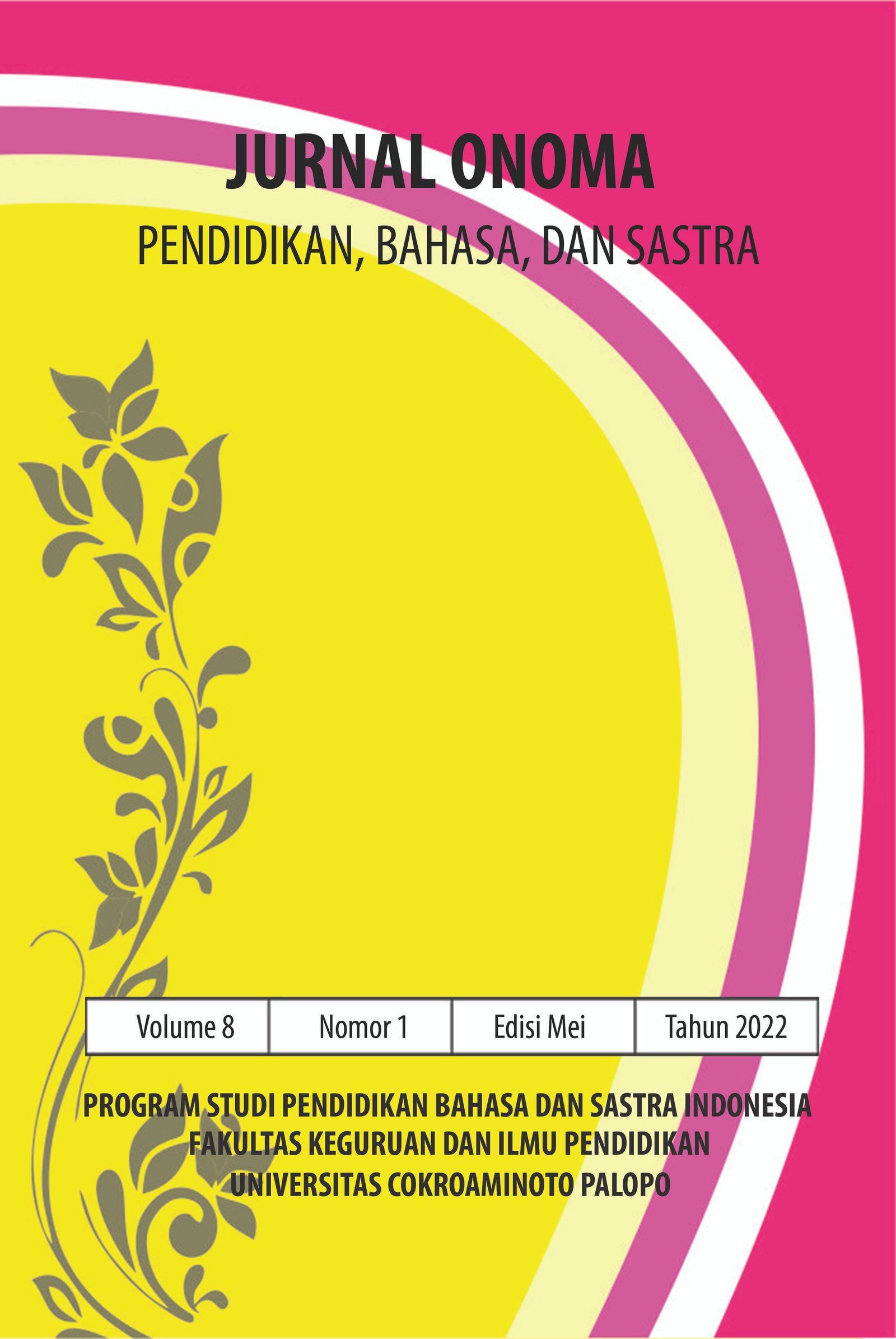Pembelajaran Drama Monolog dengan Menggunakan Model Bermain Peran dan Resepsi Siswa SMA Negeri 1 Beo
https://doi.org/10.30605/onoma.v8i1.1742
Keywords:
pembelajaran, Drama Monolog, Resepsi SiswaAbstract
Tujuan penelitian ini adalah pembelajaran drama monolog dengan menggunaka model bermain peran bagi siswa kelas XI SMA Negeri 1 Beo. Dalam perkembangan pendidikan, drama bukan lagi sekedar alat yang memainkan permain, tetapi alat untuk menyampaikan ilmu yang ada di dalam pendidikan formal. Metode yang digunakan dalam penelitian ini adalah deskriptif kualitatif analitik dengan mendeskripsikan atau gambaran terhadap objek penelitian yang diteliti melalui sampel atau data yang dikumpulkan. Sejalan dengan penelitian ini maka siswa dalam kategori sangat mampu yaitu pada rentang nilai 90-100% sebanyak 3 orang, dengan jumlah nilai masing-masing. S01, S05 dan S08 mendapatkan nilai 90 siswa dikategorikan sangat mampu adalah siswa yang benar-benar memahami penjelasan tentang materi yang diberikan mengenai drama monolog menggunakan model bermain peran dan resepsi siswa. Secara umum hasil penelitian menunjukkan adanya perubahan dalam berdrama monolog. Hal ini dirunjukan dengan melihat tingkat keberhasilan siswa secara keseluruhan mencapai nilai rata-rata 81.00%. Resepsi siswa terhadap pertunjukan drama monolog Mesin Tik Yang Tak Mati pada siswa kelas XI SMA Negeri 1 Beo menunjukkan langsung diberikan kuesioner untuk dijawab pertanyaan-pertanyaan tentang drama monolog tersebut.
Downloads
References
Suparman, S., & Charmilasari, C. (2017). Analysis of Phase Structure Realization in Classroom Discourse: A Study of Systemic Functional Linguistics. Ethical Lingua: Journal of Language Teaching and Literature, 4(2), 120-126.
Suparman, S. (2014). Prosesi Ritual Pascapemakaman Masyarakat Tangru Kecamatan Malua Kabupaten Enrekang. Prosiding, 1(1), 163-167.
Suparman, S., Madeamin, S., & Beta, P. (2018). Dokumentasi tradisi lisan Tana Luwu melalui film dokumenter.
Suparman, N. F. N. (2020). Struktur Wacana Berita Politik Surat Kabar Palopo Pos. UNDAS: Jurnal Hasil Penelitian Bahasa dan Sastra, 16(2), 141-156.
Suparman, N. F. N. (2019). Inovasi Leksikal Bahasa Wotu. Ranah: Jurnal Kajian Bahasa, 8(2), 219-236.
Downloads
Published
How to Cite
License
In submitting the manuscript to the journal, the authors certify that:
- They are authorized by their co-authors to enter into these arrangements.
- The work described has not been formally published before, except in the form of an abstract or as part of a published lecture, review, thesis, or overlay journal.
- That it is not under consideration for publication elsewhere,
- That its publication has been approved by all the author(s) and by the responsible authorities – tacitly or explicitly – of the institutes where the work has been carried out.
- They secure the right to reproduce any material that has already been published or copyrighted elsewhere.
- They agree to the following license and copyright agreement.
License and Copyright Agreement
Authors who publish with Onoma Journal: Education, Languages??, and Literature agree to the following terms:
- Authors retain copyright and grant the journal right of first publication with the work simultaneously licensed under Creative Commons Attribution License (CC BY 4.0) that allows others to share the work with an acknowledgment of the work's authorship and initial publication in this journal.
- Authors are able to enter into separate, additional contractual arrangements for the non-exclusive distribution of the journal's published version of the work (e.g., post it to an institutional repository or publish it in a book), with an acknowledgment of its initial publication in this journal.
- Authors are permitted and encouraged to post their work online (e.g., in institutional repositories or on their website) prior to and during the submission process, as it can lead to productive exchanges, as well as earlier and greater citation of published work.

















